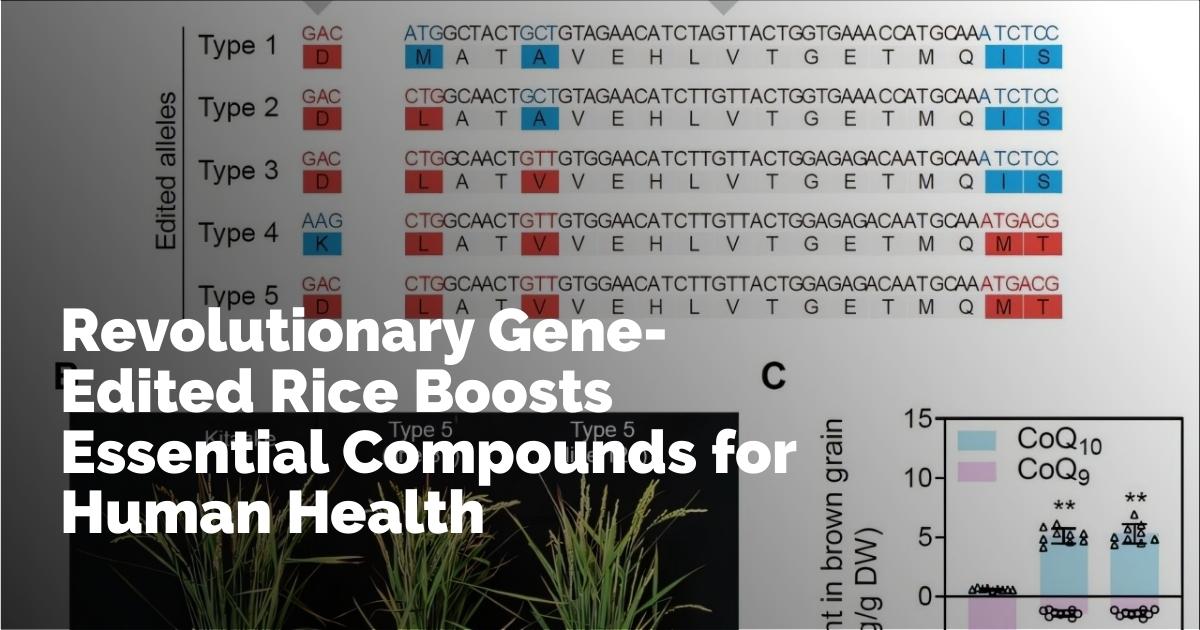A Breakthrough in Gene-Edited Rice Production
The quest for nutritional enhancement and food security has taken a significant leap forward with the advent of gene-edited rice capable of producing Coenzyme Q10 (CoQ10), a compound essential for human health. This innovative achievement stems from the diligent efforts of a Chinese research team, setting a new milestone in agricultural biotechnology.
The Role of Coenzyme Q10 in Human Health
Coenzyme Q10 holds a central role in maintaining heart health. It is a critical component of the mitochondrial electron transport chain, which is instrumental in cellular energy production. Besides, CoQ10 functions as a fat-soluble antioxidant, protecting cells from oxidative stress. However, CoQ10 is most commonly sourced from animal-based foods and supplements, which are not universally accessible or affordable.
Gene Editing: A Leap in Crop Science
The study, led by Professor Chen Xiaoya at the CAS Center for Excellence in Molecular Plant Sciences/Shanghai Chenshan Research Center, and Professor Gao Caixia from the Institute of Genetics and Developmental Biology at the Chinese Academy of Sciences, has successfully demonstrated the power of targeted gene editing. By altering just five amino acids of the Coq1 enzyme within rice, the team has developed rice varieties that can synthesize CoQ10 instead of the more common CoQ9 produced by these cereals.
Human bodies naturally synthesize CoQ10, which has a side chain of 10 isoprene units (C50). In contrast, plants, including cereals and many vegetables, usually produce CoQ9 with nine isoprene units (C45). The development of CoQ10-producing rice offers a new, sustainable way to boost CoQ10 intake through plant-based diets, potentially revolutionizing food fortification strategies across the globe.
Unveiling the Genetic Mechanism
The molecular intricacies of CoQ side-chain length variation had remained a mystery until this study. Utilizing the comprehensive plant collections available at the Shanghai Chenshan Botanical Garden, researchers examined 134 plant samples from 67 different families, encompassing a wide range of plant life from mosses to flowering plants.
Through thorough analysis, they revealed that CoQ10 is a trait inherent to ancestral flowering plants, though many modern varieties like grasses predominantly synthesize CoQ9. This discovery underscored the evolutionary pathways that have shaped the current landscape of plant coenzymes. Machine learning played a pivotal role in identifying the critical amino acid sites that define the CoQ side-chain length.
Implications for Food Security and Health
The gene-edited rice, which exhibited up to 5 μg of CoQ10 per gram of rice grain, marks just the beginning of this frontier in crop sciences. This development not only promises to diversify the food sources of CoQ10 but also sets a precedent for how big data and artificial intelligence can be harnessed for crop improvement.
By integrating these cutting-edge technologies, scientists can expedite the breeding process, ensuring a safer and more effective method to enhance nutritional profiles of staple crops. The innovation paves the way for broader applications that could address global challenges such as malnutrition and the demand for sustainable agricultural practices.
Conclusion: A New Horizon in Crop Enhancement
The gene-editing triumph in creating CoQ10-producing rice stands as a testament to human ingenuity and the possibilities that lie ahead in agricultural innovation. By transforming rice into a viable source of this vital compound, the research not only enhances the health benefits of a globally consumed staple but also aligns with ecological and economic sustainability goals. This exit from traditional supplementation echoes the future potential of gene editing to reshape how we approach food production and dietary health globally.
출처 : Original Source

